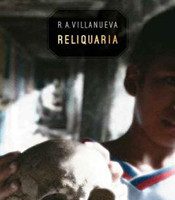Reading Reliquaria, winner of the 2013 Prairie Schooner Book Prize in Poetry, is a bit like paging admiringly through ancient accounts of human physiology—old irreconciled maps of knowledge that are random parts fact, guesswork, and myth. A sinewy, baroque landscape filled with the divine, the mortal, the alchemical, and sometimes the industrial, this collection riffs off the classical European while occasionally conjuring distinctly non-classical themes inside and against it—modern war, pollution, colonization.
The surrealist poet Joyelle McSweeney has described what she calls the “necropastoral” as “the manifestation of the infectiousness, anxiety, and contagion occultly present in the hygienic borders of the classical pastoral.” Reliquaria seems a close cousin to the necropastoral; its injection of the non-classical European contains what postcolonial scholars like Homi Bhabha would call third space, hybridity, syncretism. There is creative tension in the different worlds living together.
Catholicism forms a significant lens for many of the collection’s poems, and Baroque seems to be an influence on its language. Reliquaria is infused with the syncretic nature of colonial Catholicism—the foreign and the local lie unevenly with and in each other, creating unique reference points. The ornate rhythm of older ways of speaking peeks through the lines, alongside modern subjects and diction.
In “Blessing the Animals,” the feast of St. Francis begins with the warm purpose of the day and then crosses over into the profane via increasingly mundane and communalist Americana specifics—Elks and Legion men, the priest, the threshold of a US flag. The poem concludes with boys mischievously breaking the fingers of a statue of Christ, completing the trespass.
“As the river crests, mud-rich with forgotten things” transmutes the Raritan River, or perhaps more accurately conspires with the river to haunt itself. What could be a classic pastoral poem, of course cannot be, given that the Raritan has long been the vessel for human wastes—historical, biological, and industrial. The poem’s formal construction is fascinating as well, a kind of asymmetrical repetition of garbage, echoing the river’s layers of detritus and sludge:
… pulsing yellow muscle of the night-
to-be—flexes along each surface: driftwood night-
stands, a kingdom of algae, ash nests of cigarettes—
even the vertebrae of gulls aglow
“In Memory of Xiong Huang” is another necropastoral poem in Reliquaria, in which the body of a long lost brother is discovered by a Chinese man in the medical-aesthetic event of an exhibit of preserved human cadavers in New York City: “And he swears / he sees your red wince in the subway ads, / this bus stop poster where you have become a mannequin / of tendons [….]”
 Villanueva’s language travels the musculature of life and death, the elegant mess and occasional-grace of the human. Brandishing an evocative and well-thought vocabulary, much use is made of dense, hard sounds and rhythms. These are poems worth reading out loud to appreciate their sonorous qualities.
Villanueva’s language travels the musculature of life and death, the elegant mess and occasional-grace of the human. Brandishing an evocative and well-thought vocabulary, much use is made of dense, hard sounds and rhythms. These are poems worth reading out loud to appreciate their sonorous qualities.
Reliquaria is a collection that takes some time to consider. Its formal construction, canonical references, and sub-surface narratives require thoughtfulness and perhaps some research. In a time when sustained engagement with a text seems to be devalued, this collection is one to read not just for pleasure, but also for intellectual sustenance.




